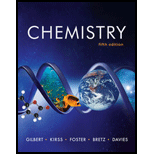
Concept explainers
(a)
Interpretation: A complete and balanced molecular equation and the overall net ionic equations for the given incomplete reactions are to be determined.
Concept introduction: A balanced chemical equation is based on the law of conservation of mass for a closed system. According to this law, the mass of the products formed in a
To determine: The complete and balanced molecular equation and the overall net ionic equations for the given incomplete reaction.
(a)
Answer to Problem 4.77QP
Solution
The balanced equation for the given reaction is,
The net ionic reaction is,
Explanation of Solution
Explanation
The dissociation reaction of
The dissociation reaction of
Therefore, the molecular equation for the reaction between
According to the law of conservation of mass, the mass of the reactants that take part in a chemical reaction is equal to the mass of the products formed in the reaction.
In the given reaction, the number of
The balanced equation for the given reaction is,
According to the solubility rule, group I cations are soluble in the solution.
Therefore,
The net ionic reaction is,
(b)
To determine: The complete and balanced molecular equation and the overall net ionic equations.
(b)
Answer to Problem 4.77QP
Solution
The net ionic reaction is,
Explanation of Solution
Explanation
The dissociation reaction of
The dissociation reaction of
According to the solubility rule, nitrates and ammonia chlorides salts are soluble in the solution.
Therefore, both the salts get soluble after mixing, neither will precipitate out as both are soluble salt.
The net ionic reaction is,
(c)
To determine: The complete and balanced molecular equation and the overall net ionic equations.
(c)
Answer to Problem 4.77QP
Solution
The balanced equation for the given reaction is,
The net ionic reaction is,
Explanation of Solution
Explanation
The dissociation reaction of
The dissociation reaction of
Therefore, the molecular equation for the reaction between
According to the law of conservation of mass, the mass of the reactants that take part in a chemical reaction is equal to the mass of the products formed in the reaction.
In the given reaction, the number of
The balanced equation for the given reaction is,
According to the solubility rule, group
Therefore,
The net ionic reaction is,
(d)
To determine: The complete and balanced molecular equation and the overall net ionic equations.
(d)
Answer to Problem 4.77QP
Solution
The balanced equation for the given reaction is,
The net ionic reaction is,
Explanation of Solution
Explanation
The dissociation reaction of
The dissociation reaction of
Therefore, the molecular equation for the reaction between
According to the law of conservation of mass, the mass of the reactants that take part in a chemical reaction is equal to the mass of the products formed in the reaction.
The above reaction is balanced equation as all the atoms present on reactant and product side is equal
The balanced equation for the given reaction is,
According to the solubility rule, group
Therefore,
The net ionic reaction is,
Conclusion
The balanced equation for the given reaction is,
The net ionic reaction is,
The net ionic reaction is,
The balanced equation for the given reaction is,
The net ionic reaction is,
The balanced equation for the given reaction is,
The net ionic reaction is,
Want to see more full solutions like this?
Chapter 4 Solutions
Smartwork5 Printed Access Card for Use with Chemistry: The Science in Context 5th Edition (SmartWork Access Printed Access Card)
 ChemistryChemistryISBN:9781305957404Author:Steven S. Zumdahl, Susan A. Zumdahl, Donald J. DeCostePublisher:Cengage Learning
ChemistryChemistryISBN:9781305957404Author:Steven S. Zumdahl, Susan A. Zumdahl, Donald J. DeCostePublisher:Cengage Learning ChemistryChemistryISBN:9781259911156Author:Raymond Chang Dr., Jason Overby ProfessorPublisher:McGraw-Hill Education
ChemistryChemistryISBN:9781259911156Author:Raymond Chang Dr., Jason Overby ProfessorPublisher:McGraw-Hill Education Principles of Instrumental AnalysisChemistryISBN:9781305577213Author:Douglas A. Skoog, F. James Holler, Stanley R. CrouchPublisher:Cengage Learning
Principles of Instrumental AnalysisChemistryISBN:9781305577213Author:Douglas A. Skoog, F. James Holler, Stanley R. CrouchPublisher:Cengage Learning Organic ChemistryChemistryISBN:9780078021558Author:Janice Gorzynski Smith Dr.Publisher:McGraw-Hill Education
Organic ChemistryChemistryISBN:9780078021558Author:Janice Gorzynski Smith Dr.Publisher:McGraw-Hill Education Chemistry: Principles and ReactionsChemistryISBN:9781305079373Author:William L. Masterton, Cecile N. HurleyPublisher:Cengage Learning
Chemistry: Principles and ReactionsChemistryISBN:9781305079373Author:William L. Masterton, Cecile N. HurleyPublisher:Cengage Learning Elementary Principles of Chemical Processes, Bind...ChemistryISBN:9781118431221Author:Richard M. Felder, Ronald W. Rousseau, Lisa G. BullardPublisher:WILEY
Elementary Principles of Chemical Processes, Bind...ChemistryISBN:9781118431221Author:Richard M. Felder, Ronald W. Rousseau, Lisa G. BullardPublisher:WILEY





